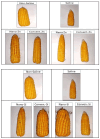Efficacy of Nano and Conventional Zinc and Silicon Fertilizers for Nutrient Use Efficiency and Yield Benefits in Maize Under Saline Field Conditions
- PMID: 40094549
- PMCID: PMC11902135
- DOI: 10.3390/plants14050673
Efficacy of Nano and Conventional Zinc and Silicon Fertilizers for Nutrient Use Efficiency and Yield Benefits in Maize Under Saline Field Conditions
Abstract
The increasing severity of salinity stress, exacerbated by climate change, poses significant challenges to sustainable agriculture, particularly in salt-affected regions. Soil salinity, impacting approximately 20% of irrigated lands, severely reduces crop productivity by disrupting plants' physiological and biochemical processes. This study evaluates the effectiveness of zinc (Zn) and silicon (Si) nanofertilizers in improving maize (Zea mays L.) growth, nutrient uptake, and yield under both saline and non-saline field conditions. ZnO nanoparticles (NPs) were synthesized via the co-precipitation method due to its ability to produce highly pure and uniform particles, while the sol-gel method was chosen for SiO2 NPs to ensure precise control over the particle size and enhanced surface activity. The NPs were characterized using UV-Vis spectroscopy, XRD, SEM, and TEM-EDX, confirming their crystalline nature, morphology, and nanoscale size (ZnO~12 nm, SiO2~15 nm). A split-plot field experiment was conducted to assess the effects of the nano and conventional Zn and Si fertilizers. Zn was applied at 10 ppm (22.5 kg/ha) and Si at 90 ppm (201 kg/ha). Various agronomic, chemical, and physiological parameters were then evaluated. The results demonstrated that nano Zn/Si significantly enhanced the cob length and grain yield. Nano Si led to the highest biomass increase (110%) and improved the nutrient use efficiency by 105% under saline and 110% under non-saline conditions compared to the control. Under saline stress, nano Zn/Si improved the nutrient uptake efficiency, reduced sodium accumulation, and increased the grain yield by 66% and 106%, respectively, compared to the control. A Principal Component Analysis (PCA) highlighted a strong correlation between nano Zn/Si applications with the harvest index and Si contents in shoots, along with other physiological and yield attributes. These findings highlight that nanotechnology-based fertilizers can mitigate salinity stress and enhance crop productivity, providing a promising strategy for sustainable agriculture in salt-affected soils.
Keywords: maize; nanofertilizers; nutrient uptake; silicon; soil salinity; zinc.
Conflict of interest statement
The authors declare no conflicts of interest. The funders had no role in the design of the study; in the collection, analyses, or interpretation of data; in the writing of the manuscript; or in the decision to publish the results.
Figures







Similar articles
-
Effects of silicon nanoparticles and conventional Si amendments on growth and nutrient accumulation by maize (Zea mays L.) grown in saline-sodic soil.Environ Res. 2023 Jun 15;227:115740. doi: 10.1016/j.envres.2023.115740. Epub 2023 Mar 28. Environ Res. 2023. PMID: 36997044
-
Zinc and Silicon Nano-Fertilizers Influence Ionomic and Metabolite Profiles in Maize to Overcome Salt Stress.Plants (Basel). 2024 Apr 28;13(9):1224. doi: 10.3390/plants13091224. Plants (Basel). 2024. PMID: 38732438 Free PMC article.
-
Synergistic enhancement of maize crop yield and nutrient assimilation via zinc oxide nanoparticles and phosphorus fertilization.J Sci Food Agric. 2024 Aug 30;104(11):6733-6745. doi: 10.1002/jsfa.13500. Epub 2024 Apr 15. J Sci Food Agric. 2024. PMID: 38551620
-
Harnessing silicon nanoparticles and various forms of silicon for enhanced plant growth performance under salinity stress: application and mechanism.Discov Nano. 2025 May 29;20(1):89. doi: 10.1186/s11671-025-04270-2. Discov Nano. 2025. PMID: 40439761 Free PMC article. Review.
-
Nano-enabled strategies in sustainable agriculture for enhanced crop productivity: A comprehensive review.J Environ Manage. 2024 Dec;372:123420. doi: 10.1016/j.jenvman.2024.123420. Epub 2024 Nov 24. J Environ Manage. 2024. PMID: 39581009 Review.
Cited by
-
Salinity stress amelioration through selenium and zinc oxide nanoparticles in rice.Sci Rep. 2025 Jul 29;15(1):27554. doi: 10.1038/s41598-025-12106-3. Sci Rep. 2025. PMID: 40731112 Free PMC article.
References
-
- Serraj R., Krishnan L., Pingali P. Agriculture and food systems to 2050: A synthesis. Agric. Food Syst. 2019;2050:3–45.
-
- FAO . Global Assessment of Salt-Affected Soils. Food and Agriculture Organization of the United Nations; Rome, Italy: 2021.
-
- Sári D., Ferroudj A., Abdalla N., El-Ramady H., Dobránszki J., Prokisch J. Nano-Management approaches for Salt Tolerance in plants under field and in Vitro conditions. Agronomy. 2023;13:2695. doi: 10.3390/agronomy13112695. - DOI
-
- Raza A., Hassan A., Abbas S., Razzaq W., Hazoor S., Nosherwan M., Rehman A., Ali I. Effects of salinity on morpho-physiological traits in six maize hybrids at the seedling stage. Agrobiol. Rec. 2024;18:41–53.
Grants and funding
LinkOut - more resources
Full Text Sources

